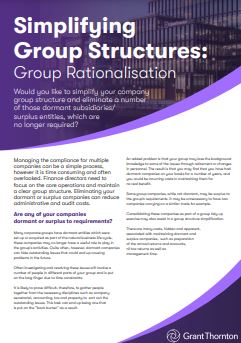
Managing the compliance for multiple companies can be a simple process, however it is time consuming and often overlooked. Finance directors need to focus on the core operations and maintain a clear group structure. Eliminating your dormant or surplus companies can reduce
administrative and audit costs.
Are any of your companies dormant or surplus to requirements?
Many corporate groups have dormant entities which were set up or acquired as part of the natural business life cycle, these companies may no longer have a useful role to play in the group’s activities. Quite often, however, dormant companies can hide outstanding issues that could end up causing problems in the future.
Often investigating and resolving these issues will involve a number of people in different parts of your group and is put on the long finger due to time constraints.
It is likely to prove difficult, therefore, to gather people together from the necessary disciplines such as company secretarial, accounting, tax and property to sort out the outstanding issues. This task can end up being one that is put on the “back burner” as a result.
An added problem is that your group may lose the background knowledge to some of the issues through retirement or changes in personnel. The result is that you may find that you have had dormant companies on your books for a number of years, and you could be incurring costs in maintaining them for no real benefit.
Some group companies, while not dormant, may be surplus to the group’s requirements. It may be unnecessary to have two companies carrying on a similar trade for example.
Consolidating these companies as part of a group tidy up exercise may also assist in a group structure simplification.
There are many costs, hidden and apparent, associated with maintaining dormant and surplus companies, such as preparation of the annual returns and accounts, nil tax returns as well as management time.
What are the options for removing these unwanted company?
Directors can apply to have dormant companies struck off the Register of Companies. To make such an application you need to be sure that you have investigated all the outstanding issues. This includes identifying and notifying both actual and potential creditors.
Voluntary strike-off conditions: A company can request voluntary strike-off provided:
- It has ceased trading or has never traded;
- All Companies Office filings are up to date;
- Within 3 months before the date of the application, the company has resolved by special Resolution to voluntarily strike the company off;
- As at the date of the application;
- Revenue approval has been given and all required Revenue filings are up to date;
- the amount of any assets of the company does not
exceed €150; - the amount of liabilities of the company
(including contingent and prospective liabilities)
does not exceed €150; - the company is not a party to ongoing or
pending litigation.
You must be sure that liabilities have not been overlooked. These could be product liabilities or employee liabilities.
Outstanding issues that could cause problems:
- Intercompany debts;
- Potential problems regarding previous assigned leases;
- Pension scheme issues;
- Potential tax problems;
- Possible contingent creditors;
- Unsatisfied Charges.
The potential dangers
If striking off is carried out without identifying and settling all the outstanding issues, creditors can apply to have companies put back on the Companies Register at any time up to 20 years following dissolution.
The emergence of any liability can lead to this happening. In this situation, any previous distribution of assets may have to be reversed and the Court will order that all historical filings of accounts are brought up to date, all of which can
be an expensive process.
A Members’ Voluntary Liquidation (“MVL”) is an option to a voluntary strike off application.
Also many of the potential dangers associated with striking off can be overcome by opting for an MVL. The outstanding issues surrounding the company still need to be investigated and resolved but certain key advantages emerge. In particular:
- the nominal share capital of the company can lawfully be distributed, provided the company is solvent or can be made so;
- except in exceptional circumstances, the company can only be put back on the Register, following dissolution, within a two year period; and
- it can be advantageous to crystallise a capital loss or gain by liquidating the company if there are other capital issues arising in the group.
The key characteristic of an MVL are:
- it is a solvent winding-up, initiated by the shareholders
with no creditor involvement; - the company directors declare that the company can pay any remaining debts in full within twelve months;
- a liquidator is appointed to wind up the entity and must get Revenue clearance to complete the wind up;
- following completion of the liquidation the company is dissolved.
While in simple cases it may be appropriate to have dormant companies struck off due to the lower cost of the strike off process, in cases with even the slightest complexity it may prove to be more cost effective to wind-up dormant companies through the MVL process.
Under the strike off process it is necessary to bring all annual returns and accounts up to date with the Companies Registry, however under the MVL process this is not always necessary and can result in savings, depending on the company’s filing history.
Domestic mergers were introduced in the Companies Act 2014 (the “Act”) and have proven to be useful tools in group simplification projects in particular, mergers by absorption and mergers by acquisition.
Domestic mergers are generally effected using the summary approval procedure (“SAP”) as provided for under the Act although a court approval procedure is also provided which may be more suitable in certain circumstances (e.g. where foreign property is held by the transferring entity and court approval is required for registration purposes in the foreign country).
Using the SAP procedure it is possible to merge two private Irish companies so that all the assets and liabilities of one are transferred by operation of law to the other, with the former company being dissolved without going into liquidation.
Mergers by absorption are regularly used to merge 100% subsidiary companies with its respective parent. Mergers by acquisition can be used to facilitate the removal of unnecessary holding companies as well as sister companies within a group.
Some key characteristics and benefits of mergers are:
- no Revenue pre-approval required;
- no reinstatement by the Companies Office has been provided for in legislation;
- no requirement for Company Office filings to be up to date;
- no liquidator required;
- fast and efficient group simplification process when compared to other processes;
- directors in control in terms of timing; directors can select the date at which the merger will be effected e.g. before an accounting year end;
- the company directors of both the transfer or company and successor company declare that the successor company will be able to pay its debts and the debts of the transferor company in full as they fall due within twelve months of the effective date of the merger; and
- any ongoing/pending litigation or contractual obligations transfer to the successor company (note: third party consent may be required in certain circumstances)
What we do
We can help you carry out the necessary investigations into the background of the dormant or surplus entities and advise in selecting the most appropriate method, or indeed methods, to reduce the number of companies in your group structure.
We can assist you in choosing the best option for simplifying your company group structure from a cost, timing and efficiency perspective. We can handle the liquidation, strike off application or merger procedure.
Our approach
We have extensive experience in carrying out investigations, handling MVLs, voluntary strike-off applications and carrying out the summary approval procedure for mergers.
- We advise many businesses on group rationalisations, tax planning and restructuring;
- We have a keen understanding of the complex interplay between the taxation, accounting and company secretarial issues involved;
- Our dedicated team of experts will work with your team in order to co-ordinate all of the relevant issues including tax planning;
- We can carry out the rationalisation of your group structures even if we are not your current advisors. This can be dealt with as a stand-alone project.
Contact
If you would like to discuss any element of these options in simplifying your group structure, please do not hesitate to call your usual Grant Thornton contact.



